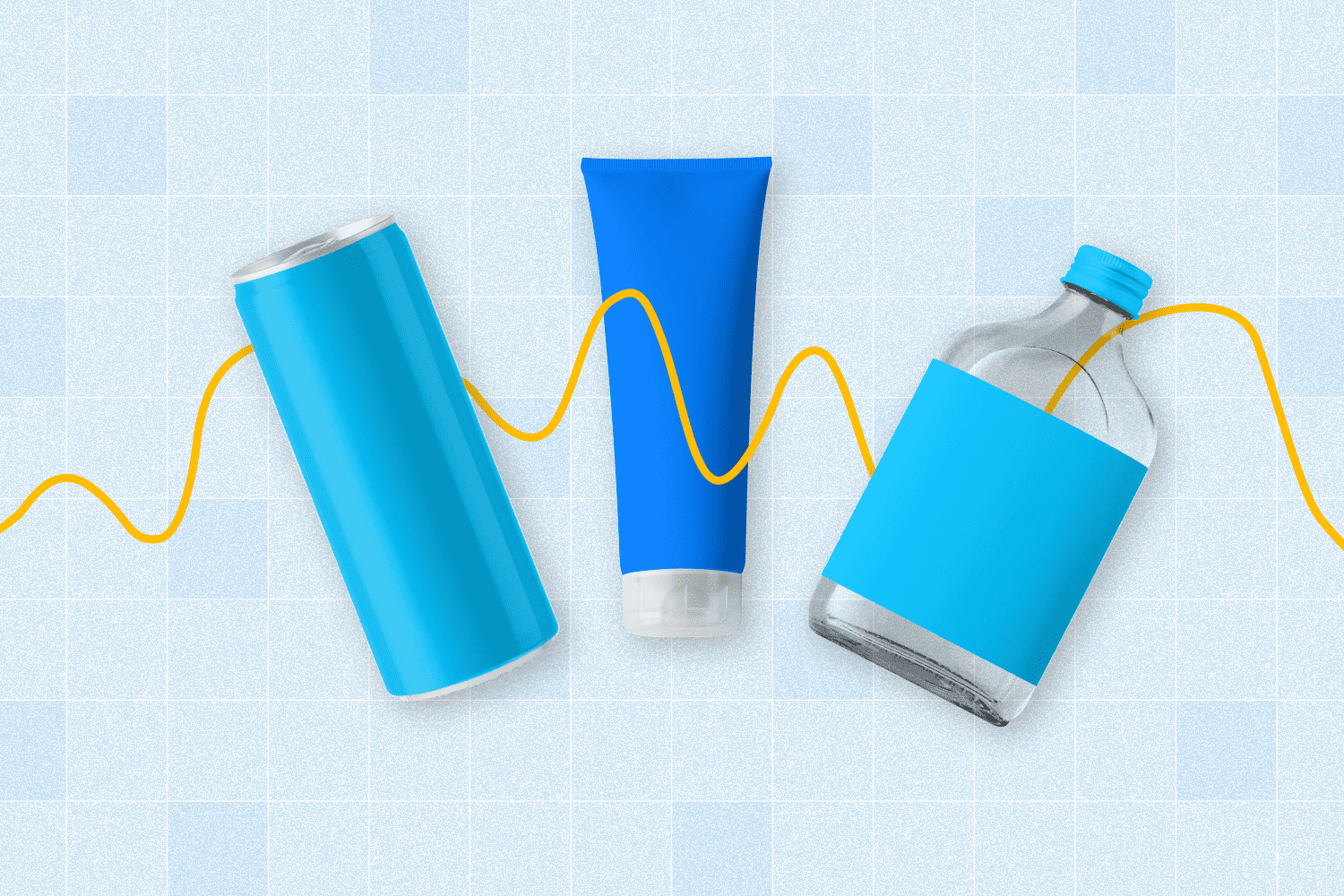In times of economic uncertainty, the Consumer Packaged Goods (CPG) industry is typically the first and most heavily impacted sector. This market is particularly sensitive to any shifts in consumer preferences or behavior and can provide valuable insights into the state of the economy at large.
In the past few years, several macroeconomic events have rocked the economy, and by default, the CPG market. The COVID-19 pandemic, international tensions, and turbulent domestic affairs have led to global supply chain shortages and contributed heavily to inflation. As prices of consumer goods continue to rise, many CPG companies are struggling to stay afloat and not fall victim to the trade down effect.
With costs of packaging, ingredients, and transportation remaining elevated, as well as on-going inflation pressure directly affecting consumers, 2023 is set to be a difficult year for this industry. However, a number of CPG companies are demonstrating the value of innovation and openness to new approaches in cultivating resilience within this uncertain time and actually thriving in the process.
For CPG companies today, it’s crucial to consistently be up on the evolution of consumer behavior, market trends, and the competitive landscape, so as to avoid information blind spots and mitigate the risk of falling behind.
A market intelligence platform like AlphaSense ensures you are the first to know of any critical shifts or developments in consumer behavior and the market. Scrawling across a vast content universe of company documents, analyst reports, expert interviews, and media outlets, an AI-based platform feeds you the precise insights needed to build a winning strategy and stay on the leading edge.
Below, we use the AlphaSense platform to dive into the main trends driving the CPG market in 2023 and analyze the implications of these trends for the future.
Top CPG Trends for 2023
Premiumization
One of the unexpected effects of the pandemic, which continues even today, is the allure of premium products for consumers. Rather than spending money on travel and holiday, consumers began allocating more dollars towards premium spirits, cosmetics, and beauty products. Consumers continue to seek out luxury health products, as wellness became a central focus for most people worldwide during the pandemic. Even pets are benefiting from this trend, as pet owners are beginning to choose higher-caliber products.
Perhaps the class of consumer goods most heavily impacted by this trend has been spirits. With the advent of COVID-19, bars and restaurants—where most people typically consumed alcohol—were shut down, leaving consumers to seek out store-bought canned cocktails or start mixing drinks at home.
Since 2019, the hard seltzer market has grown by over $9 billion in revenue. More and more, consumers are growing accustomed to the convenience of ready-to-drink cocktails and are trading up to spirit-based cocktails, as those have all the flavor, quality, and luxury of a bar-made cocktail, without the hassle or financial pressure of actually going to a drinking establishment.
Along with the spirits premiumization trend, there has been an overall decrease in alcohol consumption, both for wellness and sustainability reasons. In a Stream expert interview, a former regional manager at Moët Hennessy predicts that the premiumization effect will likely cover most of the losses from people drinking less volume.
While the instinct for companies experiencing a growth slowdown may be to cut premiumization initiatives and product costs, this will likely have the opposite effect and lead to even more customers jumping ship to a more premium competitor. In times of economic volatility, the above expert advises companies to choose a lane—whether premiumization or affordability—and stick with it through the ups and downs of the economic cycle.
ESG and Sustainability
According to a report by Deloitte, 97% of surveyed profitable growth companies in the CPG sector have stated that becoming more environmentally sustainable is a priority for 2023. Some examples of this commitment from high performers include investments in reusable packaging, deforestation prevention initiatives, and climate-friendly farming practices.
The most significant environmental concern is packaging waste and plastic pollution, as the CPG industry is by far the largest distributor of single-use plastic. Currently, plastic waste management is mismanaged, and there is likely to be tightened regulation on a global scale.
Sustainability is a particularly strong focus for food and beverage companies right now, who are turning to regenerative agriculture practices to help cut down their carbon emissions. Nestle, General Mills, and PepsiCo are a few among many brands that have invested heavily in regenerative agriculture, and more brands are continuing to join the ranks.
High performers in the CPG space are particularly focused on improving their ESG ratings, which in turn improves their profitability, as consumers and talent tend to be more attracted to companies that demonstrate ESG practices. Younger generations are especially influenced by a brand’s ESG practices—two-thirds of surveyed consumers said at least one aspect of ESG factors play a role in their purchasing decisions.
However, with the economy’s continued volatility, some consumers could become more reluctant to pay a premium for sustainability, which could mean deprioritization for some companies in the near future.
While CPG companies are some of the most ambitious in their pledges to reach net zero carbon emissions, many are unlikely to actually achieve these goals due to the significant Scope 3 emissions they have limited control over. Furthermore, there is a significant financial burden associated with reaching net zero goals, and companies will need to pull back on other business budgets or goals to devote the necessary resources to sustainability initiatives.
Digital Transformation
As is the case in most industries, digital transformation has been a consistent focus for CPG companies over the last several years. In 2023 and beyond, customers expect digital channels (online retail, apps, social media, etc.) to be an integral part of their shopping experience. They also expect convenience and speed throughout the purchasing journey, which technology has the power to enable. It’s no surprise then why CPG companies have reported an 8% increase in technology budgets over the last few years, putting extra resources into digital enhancements.
However, most of these companies still rely on manual data management processes, meaning they miss out on critical insights from product data, as well as innovation ideas. CPG companies that wish to stay competitive and continue serving their customers’ needs will need to invest in data technologies to drive end-to-end digital transformation. A cohesive data management strategy is absolutely critical in making digital technology investments worthwhile.
In the retail world, digital transformation has posed a significant challenge for smaller brands or brands with less top-of-mind recognition for consumers. This is because historically, smaller brands could piggyback off more well-known brands in department stores or on shopping streets and malls. In the digital retail space, however, these lesser-known brands can only get traffic if consumers specifically go to their brand.com website. The stronger the brand, the more likely its online success, which naturally leads to better margins and more consumer information.
The digital revolution is opening up new opportunities for emerging digital-first brands and retailers to get in front of consumers’ eyes, and consequently, is transforming the luxury retail space. Instead of glossy magazines and luxury street advertisements, the space is dominated by social media and influencers.
In the new digital era, CPG retail companies should be expecting their consumers to be largely shopping online and for luxury demand growth to be driven by these online spaces. This means faster innovation, more budget spend on marketing, and higher capital expenditure to create sustainable e-commerce capabilities. DTC digital distribution is the modern alternative to wholesale—digitally native brands can avoid material start-up losses while retaining control of pricing and distribution, and once they are more established, they can complement their digital strategy with physical direct distribution (i.e. Warby Parker).
Physical stores now need to be more dazzling and impressive than ever—if less numerous—because their new focus is more presentation-based than strictly commerce related. Stores are trying to give consumers more reasons to shop in person and to spend more time at the stores (with in-store events, exhibits, and complementary experiences). Pop-up stores will become more prevalent because they require less continuous expense and generate more excitement. These concept stores are designed to be shared on social media platforms, bridging the divide between physical and digital.
Personalization, Customization, Convenience
In the digital age of consumerism, shoppers are expecting a shopping experience that feels tailor-made for them—60% of consumers have stated that they will become repeat customers after a personalized shopping experience.
“Today’s shoppers expect convenient and personalized engagements in every interaction, across all touchpoints. Retailers and brands must work to seamlessly deliver meaningful experiences that delight shoppers and drive loyalty.”
– Jim Hertel, SVP Analytics | Inmar Intelligence
That’s why direct-to-consumer brands are currently so popular with modern shoppers. Customers feel seen and understood by the brand—as the marketing and product experience feels tailored specifically to their desires—which leads to a deeper connection and affinity with the brand, particularly when they also follow it on social media.
Digital-native brands are particularly adept at creating these kinds of customized experiences, through quizzes and surveys used to inform product recommendations. But even large established retailers like Target and Walmart are catching on to this trend by merging online and in-store offerings and adding hands-on experiences, like AI tryouts, to keep customers engaged.
Industry behemoth Nestlé is currently focused on growing its DTC verticals so as to increase product personalization and customization, as well as to remain competitive with smaller DTC companies that have been steadily absorbing Nestlé’s market share, according to a Stream expert interview.
Similarly, there is a strong trend of moving away from “one size fits all” messaging and toward greater inclusivity, particularly in the beauty and personal care industry. Established brands are increasingly designing products with inclusivity in mind, such as the L’Oreal Hapta—a recently debuted motorized makeup applicator device for those with disabilities.
Meanwhile, subscription business models are increasingly growing in popularity because they emphasize convenience and feel more personalized to the customer’s unique needs. They also happen to be a tremendous tool for CPG companies to retain their existing customers.
According to recent data, almost 35% of weekly online shoppers use subscriptions, and this number is expected to keep growing. By relying on subscriptions, CPG companies can also get away with selling smaller product sizes and avoid customer friction associated with rising product costs, all while lowering their environmental footprint by using less raw materials.
Omnichannel Sales Growth
While in-store foot traffic took a sharp decline during the 2020 COVID-19 pandemic, it has largely recovered in the last few years as life went back to normal and shoppers began frequenting brick-and-mortar stores once again. Yet one major trend that has persisted before, during, and after the pandemic is omnichannel sales—combining online and in-store shopping through multiple interconnected customer touchpoints.
Omnichannel sales have been steadily rising in the last few years, in part due to the aforementioned trends of digitalization in the industry and heightened consumer expectations for convenience in the shopping experience. But another major reason is that Gen Z shoppers now make up over 40% of all online shoppers. These young consumers are used to being able to seamlessly tie together their shopping experience across devices and in-store, creating a big selling point in this arena for companies. Even outside Gen Z, 86% of all shoppers are now combining online and in-store shopping, according to Nielsen IQ data.
Studies have shown that brands that offer robust omnichannel experiences can boost their revenue by 19%, and brands that use at least three channels in their retail strategies see a 287% higher purchase rate compared to single-channel brands. By bringing the shopping experience to individual consumers’ preferred platforms, companies can create a better experience and build stronger brand loyalty, while casting a wide net. Some of the key players leading the charge are Coca-Cola, Colgate-Palmolive, Dove, and L’Oreal.
A key point of consideration for CPG companies wanting to engage in omnichannel sales is consistent branding. This is imperative to ensure customers can easily recognize a company whether they are walking by a new product on a shelf or scrolling past it on a mobile device—and it again builds brand loyalty. On a related note, social media is becoming an increasingly lucrative e-commerce channel for CPG companies, as many customers rely on apps like Instagram and TikTok for shopping inspiration and validation.
CPG Global Market Trends
North America
The United States CPG market has been outperforming predictions in the first half of 2023, leaving investors nervous for a forthcoming decline in organic growth and slower rates of margin recovery. Companies have been forced to contend with waning consumer demand and ongoing retailer pressure, leading to underperformance in some key areas. Overall, CPG stocks are performing remarkably well due to US/European banking sector volatility causing a more defensive posture across the market and encouraging fund flows to sectors such as Consumer Staples.
Analysts believe that CPG organic sales performance will become a negative sentiment driver as YoY sales growth decelerates and growth margin upside continues to play out in the CPG group through the end of 2023. Additionally, Morgan Stanley analysts predict that consensus growth margin estimates are too low, particularly in household supplies where costs are dropping off more.
China
China’s economy has struggled considerably in recent years due to COVID-19 factors, geopolitical instability, and East-West tensions. Nevertheless, Chinese executives are confident about the prospects for CPG performance and plan to improve their operating margins by increasing prices and investing in profitable growth and operational excellence.
Most executives are expecting revenue and profits to increase throughout 2023, though they anticipate certain challenges—such as supply chain operations, sales growth, sustainability, and digital transformation—in meeting business goals.
Even more so than in the West, Chinese companies are focusing on adapting to changing consumer needs through better analytics capabilities, faster product innovation, and more consumer data. One of their main priorities is accelerating the move to digital platforms and technologies, including improving data security and personalization of the customer experience.
Japan
Going into 2023, Japan found itself in an ambiguous economic state.. Retail spending growth increased as lifting of COVID-19 bans unleashed pent-up consumer demand, but the sharp rise in food and energy prices and a fallen yen have weakened household incomes. Japanese executives don’t anticipate relief from these negative headwinds anytime soon, but they are still optimistic about future CPG prospects.
The majority are expecting revenue, market share, and profits to increase throughout the second half of 2023 and future quarters. The main strategic focus is increasing transparency for customers and partners, as well as emphasizing digital transformation. Executives unanimously agree that faster product transformation, better innovation, and more omnichannel sales capabilities will be key in meeting changing consumer preferences and navigating the tricky economic environment.
Europe
For Europe, the effects of inflation have been most severe in terms of food costs, with food inflation as much as double general inflation in some countries. This unprecedented inflation hit grocers particularly hard, as consumers began trading down. This downtrading has led to considerable growth for private labels.
In 2023, the European grocery sector is slowly recovering, as inflation is expected to abate. Still, European CEOs expect inflation, downtrading, and an increased focus on private labels to be the predominant trends of the year.
The second half of 2023 is expected to bring a gradual normalization of price and volume, a search for cheaper food alternatives, continued margin and cost pressure, a race for economies of scale, profitable online growth, retail media expansion, accelerated technology deployment, and a greater focus on sustainability.
India
While global inflation, international wars, and geopolitical issues have ripple effects on economies everywhere, the FMCG sector (a CPG subsector) in India has been much more resilient than some of its global counterparts. Purchases made for out-of-home consumption are on the rise, after a sharp decline during COVID-19, but inflationary pressures have reduced consumer spend overall.
Consumer price sensitivity is still high, and many consumers are trading down to avoid compromising on purchasing essentials. In general, consumer outlook for the year is bleak, as they expect inflation to continue rising and budgets to be further squeezed.
Middle East & Africa
Unsurprisingly, the MEA region is dealing with similar issues in the CPG sector as its global counterparts. Record-setting inflation, the fallout from a global pandemic, and extreme weather events have contributed to an economically uncertain reality. Consumers are deeply aware of their spending habits and budgets, looking to safeguard their financial stability in the face of ongoing socioeconomic hurdles.
Consumer retention will be particularly challenging in such an environment, which is why it is key for CPG companies to prioritize developing a deep understanding of their consumer base, with personalization and relevance at the forefront of ensuring brand loyalty.
Additionally, omnichannel shopping is expected to continue dominating the retail market in this region, especially for shoppers with a cost-cutting mindset. To solidify consumer support, retailers should develop an ecosystem of stores, online ordering, shipping, and rapid delivery, as well as frequent in-store sales and promotions.
Overall, despite financial pressure, consumers in the region expect and plan to spend more on categories they feel will boost their health and prosperity in the long run, like grocery and household items.
Australia
Australia is an interesting case study, as consumers there differ from those in the rest of the world.
“Our research supports the fact that Australians are different. So when we look at global consumers and get global data, it doesn’t necessarily work in this market. Australian consumers love their freedom. They’re pleasure seekers. Material security is important to them. They want to enjoy life. Health and fitness are very important to them. These personal values drive their thinking. And marketers can tap into that opportunity to find better ways to connect with the Australian consumer.”
– Mitesh Khatri | GfK’s Head of Consumer Intelligence and Consulting ANZ
This makes it particularly important for CPG companies to prioritize value alignment and product personalization that truly meets their customers where they are.
Additionally, two major consumer trends emerging in the region are a tendency toward mindful spending and bringing nature into daily life. Companies need to provide consumers with solutions that help them adapt to current economic pressures, while also honoring their appreciation for nature by prioritizing ESG and carbon emission reduction goals.
How CPG Companies Can Succeed in 2023 and Beyond
In 2023, CPG companies are still encountering workforce, supply chain, and inflation obstacles. As these issues drive prices upward, consumers are changing their spending habits in search of a better value. They are, more than ever, prioritizing convenience, spending much of their time online, and choosing brands that share their values.
In order to stay operational and profitable, CPG companies must pay attention to these shifts in customer behavior, preferences, and expectations—and they must be ready and willing to evolve with them.
The profitable growth companies that will be able to successfully use the current market instability and uncertainty as an opportunity to become even more successful will be doing the following things:
- Investing in DTC channels, digital technologies to improve customer and employee engagement, and personalization of the customer experience
- Investing in ESG reporting, increasing the company’s positive impact on society, and committing to diversity, equity, and inclusion initiatives
- Heavily relying on data, including first-party data that gives direct insight into consumers’ behavior and preferences, as well as data on competitor moves, market dynamics, and socioeconomic developments
In summary, these companies are working hard to keep up with evolving customer expectations and demands, even as they are shifting faster than ever before. They are nimble and innovative, authentic and transparent with their customers, eager to push the envelope of what has been traditionally done in the industry, and committed to actually taking action on issues that are important to their customers and employees.
These companies build data into their daily decision-making processes so that they can respond quickly and effectively to shifts in consumer demand. They also blend the analytic with the empathetic, striving to understand and truly connect with their customer base. This is the key to building a proactive, rather than reactive, strategy and to continuing to stay relevant and steady even amongst external shifts and uncertainty.
Stay on the Leading Edge with AlphaSense
Even for the most seasoned executive, it’s a continuous challenge to strategize for an uncertain future without any historical blueprint to rely on. That’s why it’s crucial to rely on a market intelligence platform that can help you prepare for the challenges of a volatile market by enabling you to track shifts in consumer trends, as well as the moves your competitors are making.
Our AI search technology cuts through the noise and surfaces the precise insights you need to inform strategy and help you make business decisions that compete. Our vast content universe spans company documents, analyst reports, expert interviews, and top news outlets—giving you a full-picture view of the ever-evolving market landscape. Get the competitive edge now with AlphaSense.




